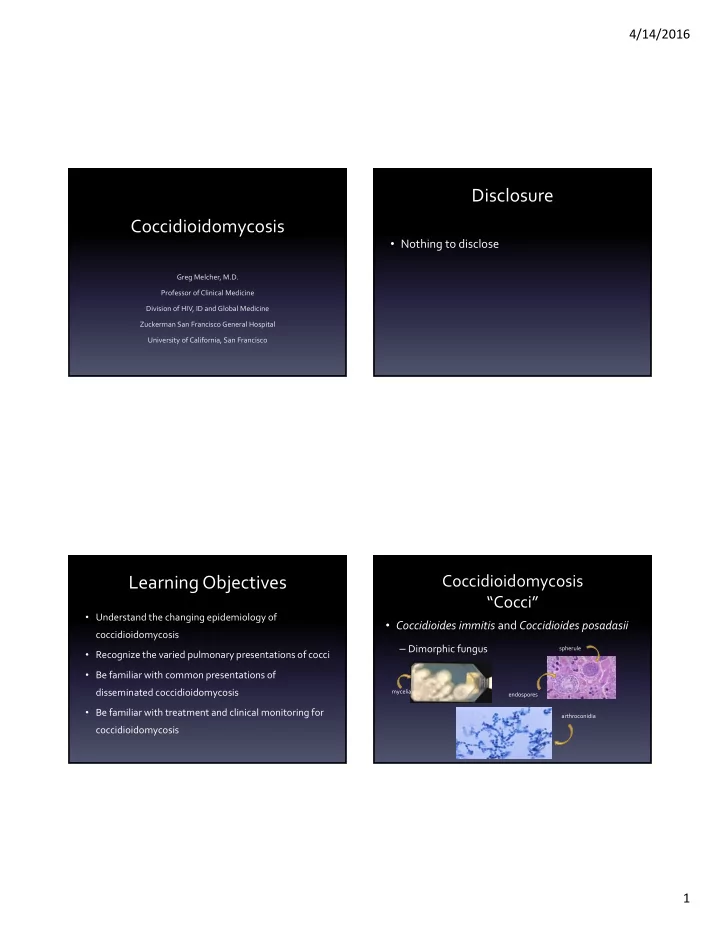

4/14/2016 Disclosure Coccidioidomycosis • Nothing to disclose Greg Melcher, M.D. Professor of Clinical Medicine Division of HIV, ID and Global Medicine Zuckerman San Francisco General Hospital University of California, San Francisco Learning Objectives Coccidioidomycosis “Cocci” • Understand the changing epidemiology of • Coccidioides immitis and Coccidioides posadasii coccidioidomycosis – Dimorphic fungus spherule • Recognize the varied pulmonary presentations of cocci • Be familiar with common presentations of disseminated coccidioidomycosis mycelia endospores • Be familiar with treatment and clinical monitoring for arthroconidia coccidioidomycosis 1
4/14/2016 The Ecology of Cocci Changing Epidemiology of Cocci Transmission of Cocci Texas Missouri 45 0.3 40 0.25 35 30 0.2 25 5.3/100K 0.05/100K 0.15 20 42.6/100K 0.28/100K 15 0.1 10 0.05 5 0 0 1998 2011 2004 2013 2
4/14/2016 Pulmonary Cocci Primary Pulmonary Cocci • 60% of infections are asymptomatic or mild respiratory illness – 25% of community ‐ acquired pneumonia in endemic areas • Segmental or lobar consolidation, +/ ‐ regional adenopathy • Eosinophilic pleural effusion Primary Pulmonary Cocci Primary Pulmonary Cocci Clinical Manifestations • Diagnosis • Cough, fever, dyspnea, scant sputum – Most often serology production • immunodiffusion tube precipitin (IgM) • Immunodiffusion complement fixation antibody (IgG) • Onset 1 ‐ 3 weeks after exposure to • EIA tests are sensitive, but not specific arthroconidia – Sputum culture – Nucleic acid testing under investigation • Possible erythema nodosum – good prognosis • Treatment optional • Pleural effusion only approximately 10% – Fluconazole 200 ‐ 400 mg/day – Itraconazole 100 ‐ 200 mg BID 3
4/14/2016 Other Forms of Pulmonary Cocci Diffuse Cocci Pneumonia Solitary Pulmonary Nodule Chronic Progressive Cavitary • High inoculum • Immunosuppression • Pregnancy • Treatment may be prolonged Treatment indicated ‐ prolonged No treatment required • • Disseminated Coccidioidomycosis Disseminated Coccidioidomycosis Risk Factors • Filipino or African • HIV/AIDS ethnicity • Diabetes mellitus • Immunosuppression • Pregnancy – Prednisone • Cardiopulmonary – TNF ‐ inhibitors disease – Chemotherapy • CF titer > 1:16 – Organ transplantation Stockamp N, Thompson GR. Infect Dis Clin N Am, 2015. http://dx.doi.org/10.1016 4
4/14/2016 Diagnosis of Disseminated Cocci Cutaneous Cocci • Most common form of • Serology supportive if CF titer > 1:16 dissemination • Definitive diagnosis • Non ‐ healing, wart ‐ like – Any positive CF titer from CSF ulceration – Culture • Diagnosis confirmed by – Histopathology (spherules in tissue) skin biopsy – Histopathology with spherules – Culture often positive www.mycology.adelaide.edu.au Bone and Joint Cocci Soft Tissue Cocci • Fluctuant, usually • Painful joint or long bone painless fluid collections • Similar to other causes of • Favor bony prominences septic arthritis such as hips, spinal • Diagnosis by column, sternum and ribs arthrocentesis, synovial • Diagnosis confirmed by biopsy, or bone x ‐ ray in aspiration for direct smear and culture setting of active cocci 5
4/14/2016 Treatment of Non ‐ Meningeal Cocci Meningitis Disseminated Cocci • LP indicated for persons with symptoms suggestive of • Triazoles are the mainstay of therapy meningitis – Fluconazole 400 ‐ 800 mg daily – Blurred vision, headache, photophobia, meningismus, altered – Itraconazole 200 mg BID preferred for bone and joint disease mental status, focal neurologic finding (CN III ‐ VIII) • Monitor serum CF titer; once low or undetectable can • CSF mononuclear cell pleocytosis, elevated protein and consider lowering dose low glucose • Most clinicians consider disseminated cocci to require life ‐ • Diagnosis confirmed by CF titer or culture (rare) long therapy at lowest possible dose • Imaging studies supportive; can mimic tuberculous • Can monitor serum CF titer as marker of disease activity meningitis Stockamp N, Thompson GR. Infect Dis Clin N Am, 2015. http://dx.doi.org/10.1016 Treatment of Cocci Meningitis Complications of Cocci Meningitis • Fluconazole 800 ‐ 1200 mg daily • Hydrocephalus • Liposomal amphotericin B 5 ‐ 10 mg/kg/day – VP shunt – Intrathecal deoxycholate amphotericin B • CNS vasculitis • Voriconazole • Posaconazole • Cerebral ischemia/infarction • Isavuconazole • Vasospasm • Lifelong treatment is recommended • Hemorrhage Nguyen, C. et al. Clin Microbiol Rev 2013;26:505 ‐ 525. 6
4/14/2016 Monitoring Response to Cocci Therapy • Clinical signs and symptoms • Serial serum and/or CSF cocci CF titer – Four ‐ fold change required to be significant 7
Recommend
More recommend